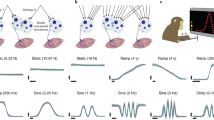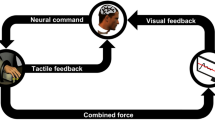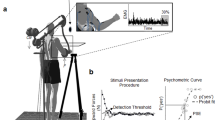Abstract
A central issue in motor control is how the central nervous system generates the muscle activity patterns necessary to achieve a variety of behavioral goals. The many degrees of freedom of the musculoskeletal apparatus provide great flexibility but make the control problem extremely complex. Muscle synergies—coherent activations, in space or time, of a group of muscles—have been proposed as building blocks that could simplify the construction of motor behaviors. To evaluate this hypothesis, we developed a new method to extract invariant spatiotemporal components from the simultaneous recordings of the activity of many muscles. We used this technique to analyze the muscle patterns of intact and unrestrained frogs during kicking, a natural defensive behavior. Here we show that combinations of three time-varying muscle synergies underlie the variety of muscle patterns required to kick in different directions, that the recruitment of these synergies is related to movement kinematics, and that there are similarities among the synergies extracted from different behaviors.
This is a preview of subscription content, access via your institution
Access options
Subscribe to this journal
Receive 12 print issues and online access
$209.00 per year
only $17.42 per issue
Buy this article
- Purchase on Springer Link
- Instant access to full article PDF
Prices may be subject to local taxes which are calculated during checkout







Similar content being viewed by others
References
Bernstein, N. The Co-ordination and Regulation of Movement (Pergamon, Oxford, 1967).
Hogan, N. Planning and execution of multijoint movements. Can. J. Physiol. Pharmacol. 66, 508–517 (1988).
Sherrington, C.S. The Integrative Action of the Nervous System (Univeristy Press, Cambridge, England, 1948).
Grillner, S. Control of locomotion in bipeds, tetrapods and fish. in Handbook of Physiology: Sect I. The Nervous System (ed. Brooks, V.B.) 1179–1236 (American Physiological Society, Bethesda, Maryland, 1981).
Bizzi, E., Mussa-Ivaldi, F.A. & Giszter, S.F. Computations underlying the execution of movement: a biological perspective. Science 253, 287–291 (1991).
Giszter, S.F., Mussa-Ivaldi, F.A. & Bizzi, E. Convergent force fields organized in the frog's spinal cord. J. Neurosci. 13, 467–491 (1993).
Mussa-Ivaldi, F.A., Giszter, S.F. & Bizzi, E. Linear combinations of primitives in vertebrate motor control. Proc. Natl. Acad. Sci. USA 91, 7534–7538 (1994).
Tresch, M.C., Saltiel, P. & Bizzi, E. The construction of movement by the spinal cord. Nat. Neurosci. 2, 162–167 (1999).
Saltiel, P., Wyler-Duda, K., D'Avella, A., Tresch, M.C. & Bizzi, E. Muscle synergies encoded within the spinal cord: evidence from focal intraspinal NMDA iontophoresis in the frog. J. Neurophysiol. 85, 605–619 (2001).
Lee, W.A. Neuromotor synergies as a basis for coordinated intentional action. J. Mot. Behav. 16, 135–170 (1984).
Macpherson, J.M. How flexible are muscle synergies? in Motor Control: Concepts and Issues (eds. Humphrey, D.R. & Freund, H.-J.) 33–47 (Wiley, Chichester, UK, 1991).
d'Avella, A. & Tresch, M.C. Modularity in the motor system: decomposition of muscle patterns as combinations of time-varying synergies. in Advances in Neural Information Processing Systems 14 (eds. Dietterich, T.G., Becker, S. & Ghahramani, Z.) 141–148 (MIT Press, Massachusetts, 2002).
Bishop, C. Neural Networks for Pattern Recognition (Claredon, Oxford, UK, 1995).
Mardia, K.V., Kent, J.T. & Bibby, J.M. Multivariate Analysis (Academic, London; New York, 1979).
Bell, A.J. & Sejnowski, T.J. An information-maximization approach to blind separation and blind deconvolution. Neural Comput. 7, 1129–1159 (1995).
Makeig, S., Jung, T.P., Bell, A.J., Ghahremani, D. & Sejnowski, T.J. Blind separation of auditory event-related brain responses into independent components. Proc. Natl. Acad. Sci. USA 94, 10979–10984 (1997).
Lee, D.D. & Seung, H.S. Learning the parts of objects by non-negative matrix factorization. Nature 401, 788–791 (1999).
Sherrington, C.S. Flexion-reflex of the limb, crossed extension reflex and reflex stepping and standing. J. Physiol. (Lond.) 40, 28–121 (1910).
Brown, T.G. The intrinsic factors in the act of progression in the mammal. Proc. R. Soc. Lond. B Biol. Sci. 84, 308–319 (1911).
Grillner, S. & Zangger, P. On the central generation of locomotion in the low spinal cat. Exp. Brain Res. 34, 241–261 (1979).
Rossignol, S. & Dubuc, R. Spinal pattern generation. Curr. Opin. Neurobiol. 4, 894–902 (1994).
Stein, P.S., McCullough, M.L. & Currie, S.N. Spinal motor patterns in the turtle. Ann. NY Acad. Sci. 860, 142–154 (1998).
Cheng, J. et al. Identification, localization, and modulation of neural networks for walking in the mudpuppy (Necturus maculatus) spinal cord. J. Neurosci. 18, 4295–4304 (1998).
Saltiel, P., Tresch, M.C. & Bizzi, E. Spinal cord modular organization and rhythm generation: an NMDA iontophoretic study in the frog. J. Neurophysiol. 80, 2323–2339 (1998).
Kargo, W.J. & Giszter, S.F. Rapid correction of aimed movements by summation of force-field primitives. J. Neurosci. 20, 409–426 (2000).
Buchanan, T.S., Almdale, D.P.J., Lewis, J.L. & Rymer, W.Z. Characteristics of synergic relations during isometric contractions of human elbow muscles. J. Neurophysiol. 56, 1225–1241 (1986).
Maier, M.A. & Hepp-Reymond, M.C. EMG activation patterns during force production in precision grip. II. Muscular synergies in the spatial and temporal domain. Exp. Brain Res. 103, 123–136 (1995).
Soechting, J.F. & Lacquaniti, F. An assessment of the existence of muscle synergies during load perturbations and intentional movements of the human arm. Exp. Brain Res. 74, 535–548 (1989).
Macpherson, J.M. Strategies that simplify the control of quadrupedal stance. II. Electromyographic activity. J. Neurophysiol. 60, 218–231 (1988).
Henry, S.M., Fung, J. & Horak, F.B. EMG responses to maintain stance during multidirectional surface translations. J. Neurophysiol. 80, 1939–1950 (1998).
Wadman, W., Dernier van der Gon, J.J. & Derksen, R.J.A. Muscle activation patterns for fast goal-directed arm movements. J. Hum. Mov. Stud. 6, 19–37 (1980).
Karst, G.M. & Hasan, Z. Timing and magnitude of electromyographic activity for two-joint arm movements in different directions. J. Neurophysiol. 66, 1594–1604 (1991).
Flanders, M., Pellegrini, J.J. & Soechting, J.F. Spatial/temporal characteristics of a motor pattern for reaching. J. Neurophysiol. 71, 811–813 (1994).
Hoffman, D.S. & Strick, P.L. Step-tracking movements of the wrist. IV. Muscle activity associated with movements in different directions. J. Neurophysiol. 81, 319–333 (1999).
Scott, S.H. Comparison of onset time and magnitude of activity for proximal arm muscles and motor cortical cells before reaching movements. J. Neurophysiol. 77, 1016–1022 (1997).
Ecker, A. The Anatomy of the Frog (Claredon, Oxford, 1889).
Lombard, W.P. & Abbott, F.M. The mechanical effect produced by the contraction of individual muscles of the thigh of the frog. Am. J. Physiol. 20, 1–60 (1907).
Kargo, W.J. & Rome, L.C. Functional morphology of proximal hindlimb muscles in the frog Rana pipiens. J. Exp. Biol. 205, 1987–2004 (2002).
Lee, D.D. & Seung, H.S. Algorithms for non-negative matrix factorization. in Advances in Neural Information Processing Systems Vol. 13 (eds. Leen, T.K., Dietterich, T.G. & Tresp, V.) 556–562 (MIT Press, Massachusetts, 2001).
Acknowledgements
We thank M. Tresch for many helpful discussions and suggestions, S. Mussa-Ivaldi, M. Mezzetti, D. Grodner, A. Rebek and C. Gulledge for comments on the manuscript, S. Dalai and J. O'Vari for helping with the experiments and the analysis of kinematic data, and M. Cantor for constant and irreplaceable support. Supported by NIH-NINDS NS09343.
Author information
Authors and Affiliations
Corresponding author
Ethics declarations
Competing interests
The authors declare no competing financial interests.
Rights and permissions
About this article
Cite this article
d'Avella, A., Saltiel, P. & Bizzi, E. Combinations of muscle synergies in the construction of a natural motor behavior. Nat Neurosci 6, 300–308 (2003). https://doi.org/10.1038/nn1010
Received:
Accepted:
Published:
Issue Date:
DOI: https://doi.org/10.1038/nn1010
This article is cited by
-
Sensorimotor adaptation of locomotor synergies to gravitational constraint
npj Microgravity (2024)
-
Muscle synergy patterns as altered coordination strategies in individuals with chronic low back pain: a cross-sectional study
Journal of NeuroEngineering and Rehabilitation (2023)
-
Abnormal coordination of upper extremity during target reaching in persons post stroke
Scientific Reports (2023)
-
The spatio-temporal architecture of everyday manual behavior
Scientific Reports (2023)
-
Variability of trunk muscle synergies underlying the multidirectional movements and stability trunk motor tasks in healthy individuals
Scientific Reports (2023)



